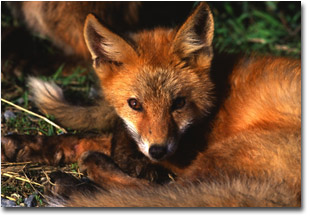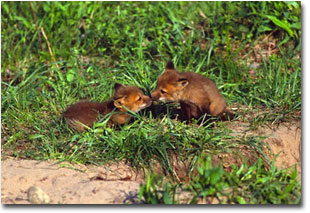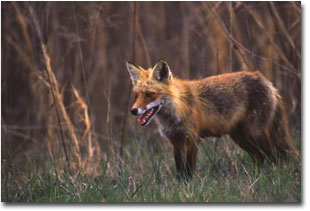|
|
 Species Profile... The Red Fox Circle - A Lesson on Survival
Text Copyright David Reinhard Introduction For years the Red Fox has been regarded as a cunning, elusive mammal. Despite massive environmental changes, these creatures have not only adapted to these changes, but have maintained a great deal of their instinctual behavior. In
The Red Fox is a dog-like animal. Its fur ranges in thickness from a thick winter coat with a bushy tail to its summer shed, which is considerably thinner. On average, they usually weigh between 7 and 12 lbs, the males (dogs) being slightly larger than the females (vixens). As part of the dog family, they have inherited a lot of the dog-like characteristics. In the picture on the right you’ll notice that Red Fox have canine teeth, a pointed dog-like snout and pointed dog-like ears. Along with the visual characteristics, a vixen will sometimes make a dog-like yap to worn her kits of possible danger. The color of the Red Fox can vary from a tan to a deep orange coat. Quite often they will have brown or black around their snout, ear tips and legs. Some Red Fox will even go through a “black phase” in which their coats are black or dark brown. Habitat Red Fox are common in just about every state in the United States. As a matter of fact, Fox are found on every continent in the world with the exception of Antarctica. Although not seen very often by humans, we share close living space with the Red Fox.
At one time exceedingly rare in the United States, they were brought here by European settlers for recreational hunting purposes. As time passed, they have expanded their territory throughout the United States. For the longest time we have misunderstood what roll the Red Fox plays in our lives. Most people have looked at them as nuisance predators.
In the past, Red Fox have been accused of killing anything from domestic cats to livestock. The majority of these accusations are simply not true. Because Fox are scavengers, perception becomes reality and what is sometimes seen by one person is merely a fraction of what actually happens. In fact, recent studies in Britain (Universities of Oxford, Bristol and Aberdeen) have shown that the majority of livestock seen taken by Red Fox have, in fact, already been dead or near death, thus accounting for more than 24% of livestock deaths. Livestock death directly caused by Red Fox accounted for less than 1% of the total livestock deaths. A Red Fox can sprint at top speeds of up to 40 mph for short distances. Their range depends on how plentiful the food source is in a given area. The less plentiful the food source, the broader the range. Most Red Fox are solitary animals and will rarely be seen in any type of pack (with the exception of a maternal den). Maternal The Red Fox mating season usually begins in December and ends in March. During this time the vixen is in estrus for about 6 to 7 days. In that period she will mate many times. Once conception takes place, she will carry her kits for 52 days. During that 52-day gestation period, instinctual behavior takes over and she will start digging or looking for a suitable den. This is the only time of the year that a Red Fox will occupy a den; they do not den for the winter. Most dens are found in areas where there are vantage points from all angles and are usually built on raised ground. The Red Fox will dig her own den or occupy another animal’s vacant den. When a Red Fox gives birth, she will stay in the den from one week to one month and nurse her newborns. After about a month the newborn kits will start venturing outside of the den. For the first one to two months the kits will stay close to the den. The Vixen will hunt for food and bring it back to the kits. During this time, kits can be seen playing around the den with each other. This play is important to the development of their hunting skills. As the kits get older, the mother will bring back live food for them to hunt and kill. Eventually the kits will start hunting on their own. At this point, the kits will be independent enough to leave the den. This whole process typically takes place over a span of five to nine months. Young Red Fox are naive and often do not recognize danger quickly. Though rare, on occasion a kit will fall prey to a hawk or eagle. Survival As a first choice, Red Fox will hunt small mammals and rodents for consumption. However, they will eat berries, plants, vegetation and insects when that is the dominant food source in their range. Most interesting is the Red Fox hunting preference. They do not have to be hungry to continue to hunt. If the opportunity presents itself, they will hunt their prey and cache it away to eat later, although, many times their cached food becomes an easy meal for another opportunistic animal. As hunters, they utilize their sight, smell and hearing. Their eyesight is exceptional; the slightest movement by
It’s most amazing to watch a Red Fox stalk an underground animal whose vibration they are feeling from above the ground. They will stand perfectly still, jump straight up in the air and pounce straight down at the center of the vibration. Once they pounce, they will start digging vigorously and if fast enough, they will catch the ground burrowing animal. If not, they will move on and try again. The Red Fox population has remained steady in areas where they have predators. In the past, Coyote have had success in preying on Red Fox and habituation to humans, though not very common has also played a role in shortening their life span. In certain areas Red Fox have become so used to humans that they take food from their hands. Whether it is obvious or not, this is something that should never be done. This is especially true for kits (also known as pups) because if a kit learns to take handouts, there is a good chance that they will never learn to hunt for themselves properly, making certain times of the year (e.g. winter) difficult to survive. Although these factors are present, and while the sport of hunting and trapping is still popular, the Red Fox population is still steadily growing in the United States. Observing these beautiful animals will always be a continuous challenge because there will always be something new to learn about the Red Fox. Every new experience is and will always be a lesson on survival. Dave Reinhard - NPN 838 Comments on NPN wildlife photography articles? Send them to the editor. |
|
|
 certain parts of the United States, the Red Fox has very few predators. For this reason, states such as Delaware, Southern New Jersey and Maryland have a healthy population of Red Fox. These small mammals can be found anywhere from dense forests to the hillsides of your local mall parking lot.
certain parts of the United States, the Red Fox has very few predators. For this reason, states such as Delaware, Southern New Jersey and Maryland have a healthy population of Red Fox. These small mammals can be found anywhere from dense forests to the hillsides of your local mall parking lot. Now people are finding that there are more benefits to these creatures. Though farmers used to put bounty prices on Red Fox, they now see their benefit in helping to keep down the rodent population and the farmers can enjoy more fruitful growing seasons.
Now people are finding that there are more benefits to these creatures. Though farmers used to put bounty prices on Red Fox, they now see their benefit in helping to keep down the rodent population and the farmers can enjoy more fruitful growing seasons. a small rodent or animal can be spotted by a Red Fox from many feet away. Red Fox are also excellent at picking up vibrations in the ground. As they feel a vibration, they quickly dig and catch whatever rodent is present underground.
a small rodent or animal can be spotted by a Red Fox from many feet away. Red Fox are also excellent at picking up vibrations in the ground. As they feel a vibration, they quickly dig and catch whatever rodent is present underground.